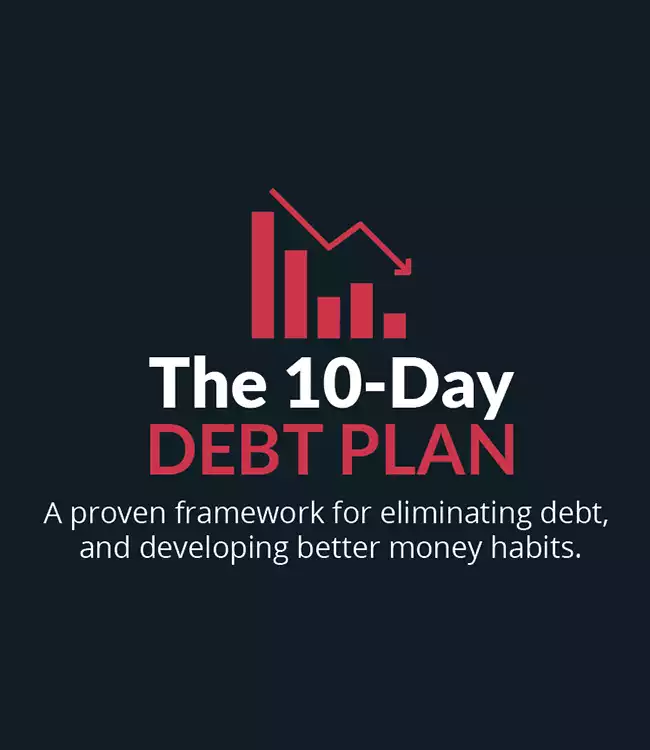- What’s a Statement Balance
- What’s a Current Balance
- What If Your Statement Shows Multiple Balances
- How Your Balance Influences Your Credit Score
- What Determines a Credit Score
- Credit Card Interest: Your APR and How to Calculate It
- How to Lower Interest Charges
- Increase Your Card Limit to Improve Your Credit Score
- Lengthy Credit History Is Good
- Final Thoughts
What if I told you the average American credit card debt is $5,300 and over 50% don’t even pay off their statement balance each month. Even more mystifying is how many don’t know the difference between the statement balance vs the current balance. Keep reading to find out.
Not knowing this distinction could cost you thousands of dollars in finance charges, fees, and penalties – every year. That’s money you could be investing or putting towards a vacation – not in the bank’s pocket.
But it’s all good. I’ve been there. I’m going to show you that it’s easier than it looks.
It doesn’t have to be confusing. You don’t need to pull your hair out in frustration and let your eyes glaze over when thinking about billing cycles, minimum payments, and finance charges.
Credit cards are a tool, and when used the right way, they can unlock rewards, cashback, and points.
Let us look at the difference between a statement balance vs current balance, factors that determine your credit score (so you can increase it while avoiding fees and penalties), and what grace periods are.
I’m also going to show you how to calculate your daily APR so you can see exactly what your credit card company is charging you in interest for every balance you leave unpaid. Trust me. It adds up.
Let’s get nerdy.
Editor's Note
What’s the Difference Between a Statement Balance and a Current Balance?
The statement balance is all of the charges made during your monthly billing cycle between the opening and closing date. The current balance reflects all of the transactions made on your card.
What’s a Statement Balance
Your credit card comes with a monthly billing cycle tracking all of the charges made on your card. It has an opening date and a closing date. The opening and closing dates can fall at any time of the month.
For example, your credit card’s billing cycle could open on April 9th and close on May 8th. It doesn’t have to open and close on the first and last days of the month.
Every transaction made during that time shows up, along with your statement balance – the amount of money charged to your credit card that you owe.
Your credit card issuer gives you a grace period to repay your statement balance interest-free. Why?
Because the Card Act of 2009 says by law, you have at least 21 days to repay your loan before your credit card company starts charging interest.
Think of your statement balance as a snapshot of every purchase made during your billing cycle.

What’s a Current Balance
Your current balance is different. It reflects all of the transactions you’ve made on your card up until now.
For example, if your statement balance is $400 with a closing date of May 8th, and you charge another $70 to your card on May 10, your current balance would be $470. Sometimes we make purchases after the billing cycle ends – and that’s fine. It happens all the time.
How to Avoid the Finance Charge
If you want to avoid paying extra finance charges and late fees, pay your statement balance on time, in full each month.
If you can’t wait to receive your credit card statement or absolutely must know what your current balance is, either call your credit card company or check your account online. Nowadays, online banking makes it easy.
You can see your minimum due date, your statement balance, and your current balance along with the APR charged to you if it’s not paid off in full.
My card even tells me how long it will take to repay the debt if I only pay the minimum due. It also shows me how much I’ll pay in interest on top of the principal. It’s a real eye-opener seeing the extra money I’d be throwing away to interest charges by only paying the minimum.
Your current balance will change daily if you’re using your card a lot. That’s why sometimes you’ll see two balances on your statement – the current balance and the statement balance.
This free course outlines a proven framework that thousands of people have used to eliminate their debt, develop better money habits, and start building a secure financial future.
What If Your Statement Shows Multiple Balances
 When your statement lists multiple balances like a statement balance, current balance, minimum due, and other – pay the statement balance. Some folks pay the entire balance and that’s ok.
When your statement lists multiple balances like a statement balance, current balance, minimum due, and other – pay the statement balance. Some folks pay the entire balance and that’s ok.
As long as you pay at least the statement balance, you’ll steer clear of finance charges.
Tweet ThisNote: Be wary of cash advances. They’re a different animal and carry a separate interest rate – usually higher. They’ve got no grace period, so you start accruing interest immediately. If you get one after your statement closes, pay it off with your next statement balance – even if it’s not listed on your account. Don’t let that extra interest build up.
How Your Balance Influences Your Credit Score
Typically, banks report your debt to credit bureaus when your cycle ends. These reports determine how creditworthy you are based on several factors that calculate your FICO score. The higher your score, the better.
The big three national credit bureaus:
- Experian
- TransUnion
- Equifax
Cocktail party trivia – FICO got its name from the software used to calculate scores by the Fair Isaac Corporation.
Note: Not all banks report your balance at the end of the billing cycle. Some report on the last day of the month like Elan Financial while others, like US Bank, report on the first of the month. Find out when your bank reports to credit bureaus.
Why This Is Important
Your credit card balance (aka credit utilization or balance-to-limit ratio) is one method used to calculate your score. You want to aim for a utilization rate of 30% or less.
For example, if you’ve got a credit card with an $8,000 credit limit and a $2,400 balance, bravo – that’s a 30% credit utilization. (2400/8000 =0.3)
Credit bureaus like to see you using the card, but they don’t want to see you run up a high balance pushing your limit. They tally up your balances across all of your cards and divide that number by your total number of credit card limits to get your utilization number.
Another example:
If you’ve got an $8,000 limit and a $7,500 balance, that’s a 93% utilization rate and negatively affects your credit score (7500/8000 = .93).
Your credit utilization is the second-most important factor determining your credit score.
So, what’s the first?
More on that below.
What Determines a Credit Score

The things that determine your credit score:
- Payment History. This makes up 35% of your score and is the number one factor which is why you ALWAYS pay your credit card bill on time. The worst thing you can do is skip a payment. Mine took a dip when I missed one. Dropped nearly 100 points – despite having an excellent credit history.
- Utilization. This one makes up 30% of your score and ranks #2 on the list. Also, be sure to have a utilization number of 30% or less.
- Length of History. 15% goes to how long you’ve held open accounts. The longer you’ve had an account open in good standing, the more reliable you’re seen in the eyes of creditors. Even better if you’ve got multiple accounts open.
- New Credit. 10% gets weighted regarding the number of credit cards you open. If you’re opening multiple accounts in a short time frame, it will cause credit bureaus to raise an eyebrow. Your score will dip because of the hard inquiries, but it’s minor, and your score will increase after a few payments.
- Credit Mix. 10% goes towards your mix of credit cards, installment loans(like car loans), and retail accounts. Having several different types of accounts open and in good standing is fantastic. Having a few accounts open can lower it.
Your score is the combination of all your credit cards, retail accounts (like Macy’s), installment loans, finance company accounts (consumer loans), and mortgage accounts.
Credit Card Interest: Your APR and How to Calculate It
You’ll need a few nuggets of information to calculate how much your bank is charging you in interest:
- Interest rate (APR or annual percentage rate)
- Average daily balance
- Number of days in the billing cycle
Note: Knowing your credit card company’s terms is essential because the APR varies from bank to bank. Some offer single APRs while others provide a variable rate. Cash advances, purchases, and balance transfers determine what you’re charged. Higher penalty rates apply when you fall behind on payments and carry an unpaid balance.
Step 1: Convert Your APR Into the Daily Periodic Rate
The first thing you’ll need to do is convert your APR into the daily rate (aka – daily periodic rate). Your APR is the annual rate the bank charges you. We want the daily rate. To do that, we’re gonna divide the APR by 365 (because there are 365 days in a year).
For example, if your APR is 16% you’d divide 16 by 365 (16/365 = .043%)
Your daily periodic rate is .043%
Step 2: Determine Your Average Daily Balance
Next, we’re going to add up all the days in our billing cycle that we carried a balance and divide it by the number of days in our billing cycle (we’ll use a 30-day billing cycle here).
For example, if you had a $1,500 balance on days 1 – 21, and then made a $500 payment on day 22 and carried your new balance of $1,000 for days 22 – 30, your calculation would look like this:
$1,500 x 21 days = 31,500
$1,000 x 9 days = 9,000
Add 31,500 to 9,000 = 40,500
Now divide the sum of your daily balances by the number of days in your billing cycle.
40,500/30 = 1,350
Your average daily balance is 1,350
Step 3: Figure Out the Interest

Lastly, multiply your average daily balance(1,350) by your daily periodic rate(.043%) by the number of days in your billing cycle (30):
1,350 x .00043 x 30 = 17.41
$17.41 is what you’ll be charged in interest if you don’t pay your statement balance in full that month.
How to Lower Interest Charges
You can reduce your interest by making multiple payments a month. This will lower your average daily balance keeping your interest charges low.
For example, if you had a $3,000 balance and paid it down to $1,500 on day 22, your average daily balance would be 2,550.
However, if you had the same balance and paid $750 on day 10 and another $750 on day 22, your average daily balance would be 2,250. You reduced your interest charge 11% by making multiple payments that month.
Search for cards with zero introductory APRs (12 – 18-month introductory periods) or cards with low APRs (14% or less).
If your APR is high, ask your bank for a lower rate. This happens all the time. It helps your case if your account is in good standing. You can even leave your bank for one of their competitors and do a balance transfer if you find a better rate that makes sense.
The better your credit score, the easier it will be to get a low APR.
Note: Only buy what you can afford. Having a rough estimate of your monthly expenses will keep you in check and give you an idea of what’s possible and what’s not. This will keep both your balance and debt low. If you need extra help, work with a fiduciary financial planner to create a road map with specific financial goals.
Increase Your Card Limit to Improve Your Credit Score
Increasing your available credit limit will lower your utilization number but only if you don’t raise your spending. This will improve your overall FICO score. Let’s break it down.
If you’ve got a credit card carrying a $2,500 balance and a limit of $3,000, your utilization rate is 83%. But if you call your bank and say you want to increase your limit to $10,000, your new utilization will be 25%. You just lowered your utilization rate and improved your credit score.
“Mathematics is the language in which God has written the universe.” – Galileo Galilei

Lengthy Credit History Is Good
Don’t close your account because you’re no longer using the card. Keep it open by:
- Setting up an automatic, monthly recurring payment like your Netflix bill.
- Set it as your default card when shopping at a specific store.
- Keep it in your purse or wallet and use it once a month for a random purchase.
The longer your credit history, the better your score. If you close an account, especially one that’s been open longest, you’ll slash your credit history way down.
Imagine you’ve got two cards, one’s been open for two years and the other’s been open for 12. If you close the 12-year account, you reduce your credit history to two years old – no longer 12 years old.
It also affects your utilization, the second-most important factor in deciding your FICO score. If you’ve got two cards, one with a balance/limit ratio of $2,500/$3,500 and the other has $1,000/$10,000, your utilization rate is 25% (3500/135000 = .25).
But if you close that second card with the higher limit, you’re left with a utilization rate of 71% (2500/3500 = .71).
Credit card companies make money off merchants and cardholders even if they’re not paying interest. If they notice you haven’t used your card in a long time, they might close your account. Be mindful of this when debating whether or not to keep your card active.
Carrying a balance won’t increase your credit score.
Carrying a balance means you’re paying more money than necessary in interest. It means for every item you buy; you’re paying the sticker price and then some. Don’t overpay for anything.
All of that extra money in interest gets taken out of your pocket and put in the banks. That’s money you could invest. Pay yourself, not the bank.
Also, don’t forget that credit and debit are not interchangeable.
They’re not the same – even if your card says Visa. Purchases made as a credit card affect your credit score. They’re not treated equally.
It doesn’t matter what you buy either. Sneakers or candy bars. A charge is a charge. It all affects your credit score. Act accordingly.
Final Thoughts
There’s a lot to consider but it’s not nearly as complicated as it’s made out to be. The differences between statement balance and current balance. How to calculate your APR and lower your interest charges. Ways to improve your credit score. They’re all critical factors used to navigate the often intimidating and confusing world of personal finance.
Knowing the information and doing something with it puts you a step ahead. You’re less likely to get caught off-guard with a late fee or new charge. Add these weapons to your arsenal. In case of emergency, break open glass.


![What Is Credit and Why It’s Essential to Your Financial Health [UPDATED]](https://www.listenmoneymatters.com/wp-content/uploads/2020/02/what-is-credit-featured-768x432.png)

